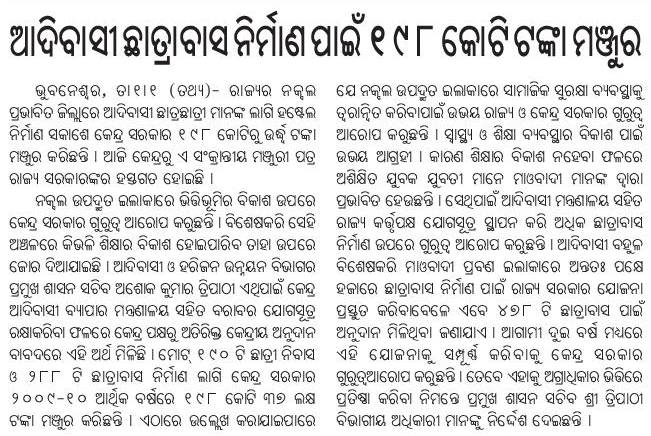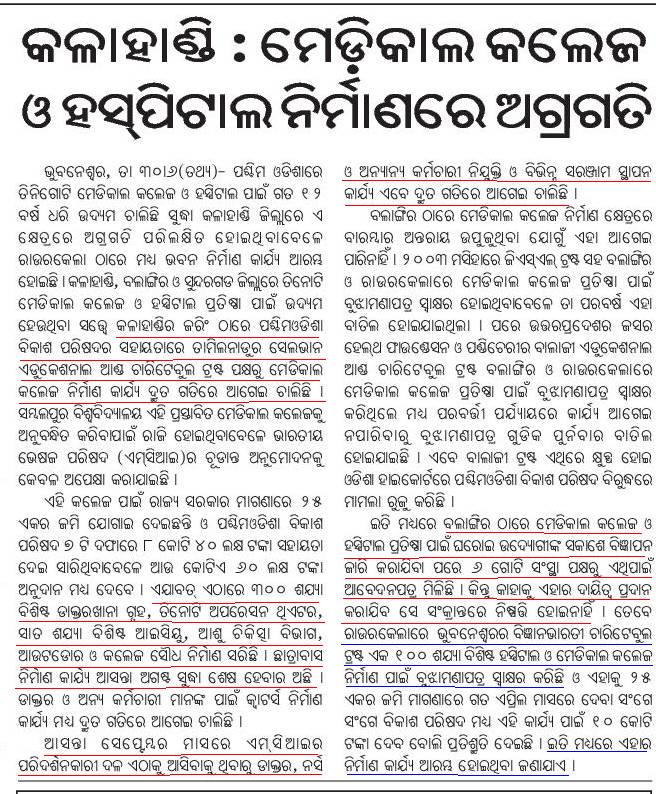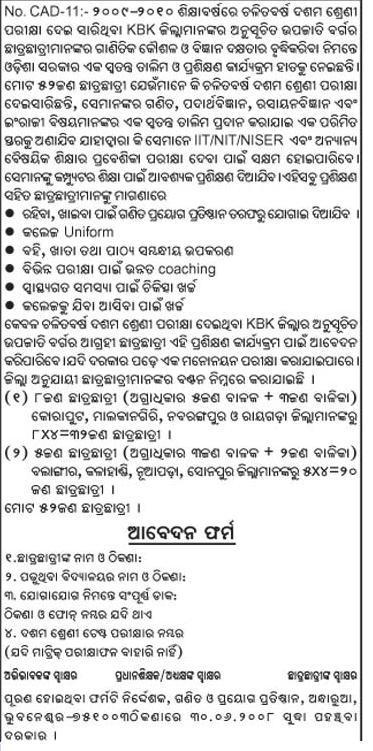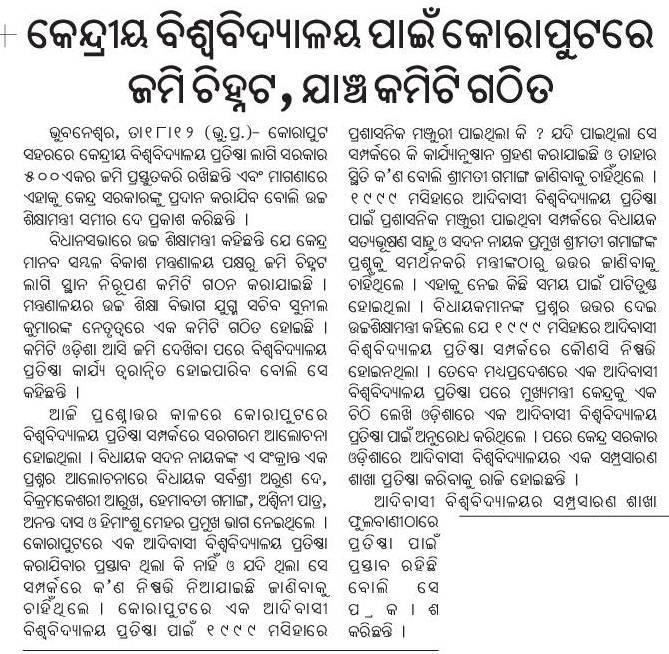The web page of Orissa Model Tribal Education Society (OMTES) is http://www.omtes.org. Following are excerpts from its "Background" page.
The Orissa Model Tribal Education Society (OMTES), a registered Society supported by the ST & SC Development Department, aims to make positive interventions in the field of tribal education. Since its inception in March 2000, it has been instrumental in setting up 11 Ekalabya Model Residential Schools in different parts of the State with assistance from Government of India. Besides that it also manages 19 Educational Complexes set up for providing education to ST Girls belonging to Primitive Tribal Groups. OMTES continues in its endeavour to serve the tribal population of the State by ensuring them to avail best opportunities in education at par with the non tribal population.
Following are some Q & A from its FAQ page.
How the schools are managed at the district level?
A school level management committee headed by the Collector of the respective districts, members including two educationist of the area looks after the overall development of the schools. Here the collector is the chairman and concerned Principal of ERMS is the Member Secretary.
I am a Tribal, what is the benefit the society has for me?
You benefit, when your child qualifies entrance of the school and receives free qualitative education. The society provides for improving the quality of tribal by promoting educational schemes for tribal community and improves the quality of life of tribal by Ashram Schools, Hostels for Tribal Boys Educational complexes, Post- Matric Scholarships and Book Bank Schemes, etc.
Whom do I contact for more information?
For information you are requested to contact ST & SC Development, Govt. of Orissa.
The 11 schools are listed in the page http://www.omtes.org/Yearwise_establishment_EMRS.html. They are in the districts of Koraput, Mayurbhanj, Sundergarh (3), Rayagada, Koenjhar, Gajapati, Kandhamal, Nabarangpur, and Jajpur.
The 19 educational complexes are listed in the page http://www.omtes.org/Yearwise_establishment.html. They are in the districts of Keonjhar (3), Rayagada (2), Nuapara, Mayurbhanj (2), Deogarh, Angul, Kalahandi, Ganjam, Gajapati (3), Malkangiri (2), Sundergarh and Kandhamala. Each of these complexes have a capacity of 250 making a total capacity of 4750.
In contrast, as of today, KISS has a student body of 15,083, which includes 3553 students pursuing +3. KISS had a student body of 1500 in 2005. I am sure the performance of the students is better at KISS than of the students at the OMTES schools and educational complexes.
So the Odisha government should just give land, seed money and grants to KISS and let them establish and manage much larger facilities in the districts with significant tribal students.
In http://www.kiss.ac.in/admission.html it is mentioned that every year KISS gets 30,000 to 40,000 applications per year for admission and admits between 2000-3000 of them. The government should fund KISS so that if not all who apply are admitted at least half of them are admitted.
It is a pity that other states have taken note of KISS and are inviting KISS to open replicas in their states while Odisha does not seem to be taking similar steps. Following is an excerpt from a report in Pioneer on other states approaching KISS for replicas.
A branch of the Kalinga Institute of Social Sciences (KISS) has been set up in Bastar, a tribal dominated and Maoist infested region of Chhattisgarh with assistance from the National Mineral Development Corporation (NMDC).
An MoU to this effect was signed between the KIIT and the KISS founder Dr Achyuta Samanta and NMDC director GB Joshi in the presence of the NMDC chairman cum managing director Rana Som at the the latter’s Corporate Office in Hyderabad on June 24.
As per the agreement, the NMDC has provided 30 acres of land along with all financial assistance to the KISS in order to set up its replica in Kankar region of north Bastar district in Chhattisgarh. In the first phase, 1000 tribal boys and girls will be admitted in this school. However, a total of 4,000 students from five districts in and around Bastar will get the opportunity of quality education here in course of time.
After Bastar, the Governments of Jharkhand, Madhya Pradesh and Delhi are keen to set up such model schools bearing all financial implications. They have requested Dr Samanta accordingly.
The page http://www.kiss.ac.in/fmngt.html explains how KISS is funded. The total amount there adds up to 18 crores. If 10 such KISS replicas are established in 10 tribal districts of Odisha at an additional cost of 200 crores/year, that will be the best use of such money for Odisha.
July 8th, 2011
Following is an excerpt from a report in tathya.in.
Prof. Gopabandhu Behera and Dr. A. K. Nanda, who are also the Governing Body member of Vedanta Science College were also present.
Mr.C Joseph, in-charge of the Vedanta Science College, Nabakrushna Panda, Principal, Government Autonomous College, Bhawanipatna, S P Nanda, Principal, Government, Women’s College, Bhawanipatna, Sudershan Rath, Principal, Bisamcuttack College and Bharat Rath, Principal Rayagada Government College also graced the conference.
The objective of the conference was to make the people conscious about the value of science education at degree level as well as to discuss about the proposed Vedanta Science College at Lanjigarh.
Dr. Kumar, President and COO, VAL, said, “Vedanta Science College was a long pending demand of the people of Western Ordisha.
He said that Vedanta is committed to create a state of art Science College that will promote quality science education in Western Odisha.
Quality Science education can help in developing technical manpower for industrialization in the state, he added.
The proposed Vedanta Science College will start its academic session from 2011.
The institution will provide education in subjects of Physics, Chemistry, Botany, Mathematics, Zoology, and Environmental Science.
It should be noted that there are very few (could be zero) fully private (i.e., without depending on state grants) science colleges in Odisha. Even the government ones and private ones that depend on state grants do not have good infrastructure and do not have adequate quality faculty. The more well known private higher education institutions of the state focus on trade oriented disciplines like engineering, management, medicine, pharmacy, biotechnology etc. so that they can charge adequate amount of student tuition. This includes deemed universities like KIIT and SOA and the private state university Centurion. None have science programs at the Bachelors level.
So if the Vedanta Science college in Lanjigarh becomes a good quality science college, then it would be a big boon to Kalahandi and Rayagada districts and hopefully it will also encourage other private groups to establish similar colleges.
January 31st, 2011
Following is a letter that Dr. Karmee has sent to many people. This is an excellent work. It is well researched and based on something unique to the location, the Gandhamardan Hills of Baragarh and Balangir. (Considering that many in Orissa may not be aware of Gandhamardan Hills being in Orissa and/or its medicinal values, I have a companion piece on it at https://www.orissalinks.com/orissagrowth/archives/2776.)
I hope others will also focus on unique aspects and attributes of other parts of orissa and write to the higher education task force (HETF) about it.
Respected Mr. Patnaik, CM of Odisha and Members of the Higher Education Task force,
I appreciate the formation of higher education task force by the state government. Also, I am hopeful that such innovative steps will definitely sharpen the higher education of Odisha.
Sirs,
I would like to request the higher education task force to recommend the establishment of a “National Institute of Ayurveda” in Gandhamardan area in western Odisha. I am sure many of us are aware of the potential of Gandhamardan mountain and medicinal plants in it.
In this document, I am presenting the details about the “Gamdhamardan mountain as a reservoir of medicinal plants” with scientific references; thereby, making a case for the establishment of a National Institute of Ayurveda.
I am sure our respected CM, who is the author of the “Garden of Life: An introduction to the Healing Plants of India” will take this matter seriously. Also, I am hopeful that the higher education task force will take the necessary steps; so that, “the medicinal plants in Gamdhamardan mountain” will not get lost with time.
Please have a look on the following write-up for further details.
Thanking you with best regards,
Sanjib
1. “National Institute of Ayurveda” is a must in Gandhamardan area: Introduction and Analysis:
Gandhamardan mountain range is known world wide as a reservoir for medicinal plants. It is located in the western Odisha. More specifically, it is located in between Balangir and Bargarh district (Figure 1).
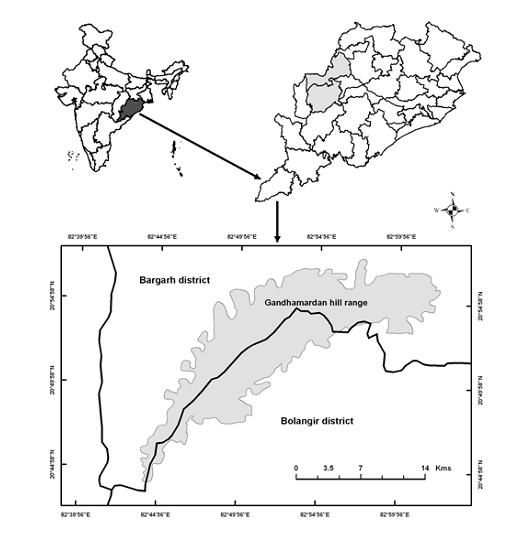
Figure 1 Map showing location of Gandgmardan mountain in between Balangir and Bargarh district
Many eminent scholars of life sciences have done a lot of research on the medicinal plants available in this mountain range. In fact, this hill range is legendary. It has found a place in folklore and mythology -of how Hanuman plucked Bisalyakarani, a medicinal plant, from this hill to save the life of Laxman in the battle of Lanka in “The Ramayana”. In addition, it is known to the whole world how this hill range was at the centre of one of the most prominent ecological movements, that is, the battle between environmentalists keen on protecting aryurvedic plants and the then state-owned Bharat Aluminium Corporation.
Apart from this, there are many scientific journals and books that are mentioning about the potential of medicinal plants available in Gandhamardan mountain (see the reference list)1-5. The state/central govt must establish a “National Institute of Ayurveda” in this place. Right now, both Balangir and Bargarh (Paikmal) each have one Ayurvedic College. Establishing a national level institute on Ayurvedic Medicine will help to a great extent to these colleges by carrying out research in emerging areas. Recently, research on ayurvedic medicine is attracting considerable attention in India and abroad.
It is important to note that, significant developments have boosted systematic research on different aspects of ayurveda and traditional medicine in India. They include the Golden Triangle project jointly managed by CSIR, ICMR and AYUSH; the New Millennium Indian Technology Leadership Initiative (NMITLI) of CSIR and various schemes of DST and DBT.
Additionally, ayurveda is also entering to the mainstream “Drug Discovery”. Following graph show the growing demand of research on Ayurvedic medicine.
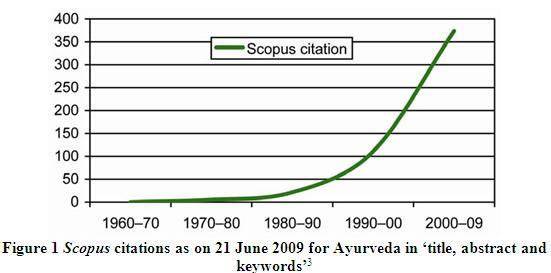
In addition to this, a paper by “Reddy and Pattnaik” from the Forestry and Ecology Division, National Remote Sensing Centre, Hyderabad 500 037, Andhra Pradesh, India points out many interesting facts about “Gandhamardan hill” 4.
It states that, after analyzing and studying the plant resources of Gandhamardan hill range a total of 912 vascular species belonging to 556 genera under 142 families were found. Herbs dominate the flora followed by trees, climbers and shrubs.
Therefore, proper conservation and management plans are needed to save the natural resources, especially medicinal plants, of this sacred hill range. Many botanists fear that this reserve of medicinal plants could be lost in the next few years if proper care is not taken and the indiscriminate collection and smuggling of herbs by local villagers is not stopped. The state forest department which is supposed to guard this botanical wealth is not able to do enough to stop all these developments because they lack of the knowledge and expertise about these plants. In fact, they have no clue which are useful medicinal plants and which are not.
In addition, in these places there is no organized way of farming of the medicinal plants. They just grow in the wild. Therefore, it is very difficult to guard these species. Taking the advantage of this situation any villages or smugglers can walk into the forest and collect the herbs. It is very important that the government should takes steps to grow these plants, harvest these properly, and finally do the marketing of these medicinal plants and herbs in a well organized manner. It should take care of the cultivation and preservation of these plants like it is doing for other forest products like sal seeds or kendu leaves etc.
However, intellectually this problem can be solved by establishment of a National Institute of Ayurveda. The above discussion/ description/ scientific observation strongly suggests the establishment of a National Institute of Ayurveda near Gandhamardan mountain.
2. Following are some of my points in support of establishing a National Institute of Ayurveda in Gandhamardan area:
* West is very much keen on establishing institute on ayurveda. One such successful institution is the National Institute of Ayurvedic Medicine established by Dr. Scott Gerson, USA, (http://niam.com/corp-web/index.htm). This is an example of an institute that has carried out research into Ayurvedic practices to a great extent. In this context, we must use our native expertise. In addition, the National Institute of Ayurvedic Medicine, USA can be a collaborative partner for establishing an institute Gandhamardan area.
* This mountain is very important to all of us and to the world. We should use our natural medicinal resources very judiciously. It is also very surprising that no steps have been taken for the preservation of these high-valued plants. It is the right time to establish a National Institute of Ayurveda in this area.
* As we know this mountain range is a reserve for medicinal plants. Therefore, it will provide adequate environment for cutting edge research/studies in different areas of ayurvedic medicine per international standard.
* Establishment of a National Institute of Ayurveda will help for organized way of farming the medicinal plants; which just grow in the wild. This will also help in preserving different rare species of plants.
* This Institute will provide a boost to the ongoing research/academic activities by Ayurvedic College Balangir and Shri Nrusinghanath Ayurved College Paikmal, Bargarh on this area. Along this line, establishing a National Institute of Ayurveda will make this place a leader in this area of science in national/international level.
* This step will attract companies like Dabur, Ayur, and others to set-up labs/companies in this area.
* From the above discussion it is very clear that research fundings are already available from the leading agencies of India like CSIR (Council for Scientific and Industrial Research), DST (Department of Science & Technology), and DBT (Department of Biotechnology). So, there will be no problem in setting up labs and developing infrastructure.
* There is a lot of synergistic research going on between Ayurvedic, Homeopathic and Allopathic branches of medicine. This is very clear from our day-to-day life as Allopathic doctors often prescribe medicines of Dabur, Neem, etc. Therefore, establishment of such an institute will further enhance the research between this National Institute of Ayurveda with other institutes viz. VSS Medical College, SCB Medical College etc. of the state.
3. The following steps need to be taken to establish a National Institute of Ayurveda in Gandhamardan
* It is important to look in to the web-site of these model Institutes viz. National Institute of Ayurvedic Medicine, USA (http://niam.com/corp-web/index.htm); Gujarat Ayurved University Jamnagar, Gujrat, India (www.ayurveduniversity.com); Rajasthan Ayurved University, Jodhpur Rajasthan (http://www.raujodhpur.org/aboutus.html); National Institute of Ayurved, Jaipur, Rajasthan (http://nia.nic.in/); Ayurvedic university, Hoshiarpur, Punjab; (http://www.financialexpress.com/news/punjab-clears-first-ayurvedic-university-in-hoshiarpur/517911/; This seems to be a new Institute).
* Immediately, the state govt. should present a proposal to the HRD Ministry for establishing National Institute of Ayurveda in Gandhmardan area.
* Along the line of the above institutes, the state govt. in collaboration with govt. of India must establish a National Institute of Ayurveda in Gandhamardan area.
References:
1. Netra Bhanu Pradhan, Gandhamardan – A treasure House of Medical Plants, Navaratna Journal, Jan-Feb, 2008, 41-44.
2. Ayurveda: scientific research and publications, Current Science, 2009, 97( 8), 1117-1122
3. C. Sudhakar Reddy and Chiranjibi Pattanaik, An Assessment of Floristic Diversity of Gandhamardan Hill range, Orissa, India. Bangladesh J. Plant Taxon. 16(1): 29-36, 2009
4. Following are some of the research papers taken from the reference list of the paper 3 (Papers only with the name Gandhamardan are taken)
Brahmam, M. and Saxena, H.O. 1990. Ethnobotany of Gandhamardan hills – Some noteworthy folk medicinal uses. Ethnobotany 2: 71-79.
Brahmam, M. and Saxena, H.O.1990. Phyto-chemical screening of the plants of Gandhamardan hills of Orissa (India) for tannins, saponins, flavonoids and alkaloids. Asian J. Plant Sci. 1: 71-79.
Misra, R.C. 2004. Therapeutic uses of some seeds among the tribals of Gandhamardan hill range, Orissa.Indian J. Traditional Knowledge 3: 105-115.
Misra, R.C. and Behera, G. 1998. Ecological status of Gandhamardan forests using remote sensing techniques. In: Biodiversity Conservation: Problems and Prospects. Proc. National Seminar on Biodiversity Conservation, Bhubaneswar, India, pp. 75-80.
Misra, R.C. and Das, P. 1998. Vegetation status of Nrusinghanath – Harishankar complex, Orissa. J. Econ.Taxon. Bot. 22: 547-554.
Mishra, R.C. and Das, P. 2003. Wild poisonous seeds: Some notable species from Gandhamardan Hill ranges of Orissa. J. Econ. Bot. 27: 513-518.
Misra, R.C. and Das, P. 2004. Vegetation stratification of Gandhamardan hill range, Orissa using remote sensing techniques. J. Econ. Taxon. Bot. 28: 429-438.
Mishra, R.C., Panda, P.C. and Das, P. 1994. Lesser known medicinal uses of plants among the tribals of Gandhamardan hill ranges, Orissa. In: Gupta, B.K. (ed.), Higher Plants of Indian Subcontinent, Vol. III, Bishen Singh Mahendra Pal Singh Publications, Dehra Dun, India, pp. 135-142.
Mishra, R.C., Panda, P.C. and Das, P. 2001. A taxonomic study of the ferns and fern allies of Gandhamardan hills, Orissa. J. Econ. Taxon. Bot. 25: 577-590.
Panigrahi, G. 1963. Gandhamardan Parbat, Orissa – A potential source of important indigenous drugs. Bull. Reg. Res. Lab. 1: 111-116.
Pattanaik, C. and Reddy, C.S. 2007. Medicinal plant resources of Gandhamardan hill range, Orissa: An urgent need for conservation. Natl. Acad. Sci. Lett. 30: 35-38.
Raju, D.C.S. 1960. Vegetation pattern of Gandhamardan hills. Bull. Int. Soc. Trop. Ecol. 1: 21-22.
Saxena, H.O. and Brahmam, M. 1995. Vascular flora of Gandhamardan hills. J. Econ. Taxon. Bot. 19: 113-132.
5. NOTE: This is not the complete list of references. Because of time limitation I have collected as much as I can.
November 4th, 2009
Following is an excerpt from a report in e-pao.net.
New Delhi, November 11 2008:
STATE CHIEF Minister Okram Ibobi along with the Education Minister L Jayantakumar and the Tribal Development Minister DD Thaisii met Prime Minister Dr Manmohan Singh at the Prime Minister’s Office here this afternoon in connection with the reservation policy for recruitment of scheduled tribes in Manipur University and opening of a regional centre of the Indira Gandhi National Tribal University in Manipur.
During the half an hour meeting, Chief Minister Ibobi told the Prime Minister that the Manipur University, which was a State University , became a Central University in the year 2005.The All Tribal Students’ Union of Manipur (ATSUM) and Manipur University Tribal Students’ Union (MUTSU) had been requesting the Central Government as well as the State Government seeking adoption of the State Government’s reservation policy in matters of recruitment in the Manipur University.
The Chief Minister further stated that based on the population composition of Manipur, the reservation policy of the State Government stipulated 31 pc reservation for Scheduled Tribes and 2 pc for the Scheduled Castes, as against 7.5 pc for Scheduled Tribes and 15 pc for Scheduled Castes in the Central Reservation Policy.
As such, the State Government had recommended to the Central Government the adoption of the State Reservation Policy by the Manipur University as a special dispensation keeping in view of the ethnic composition of Manipur.
O Ibobi also referred to the establishment of the Indira Gandhi National Tribal University at Amarkantak in Madhya Pradesh by a Central Act namely the Indira Gandhi National Tribal University Act 2007.This Act empowered the University to make special provisions for the employment or admission of women, persons with disabilities or of persons belonging to the weaker sections of the society and, in particular, of the Scheduled Castes and scheduled Tribes.
The Chief Minister further expressed that Manipur had nine districts; out of which five districts were predominantly inhabited by the tribal communities.
The facilities for imparting education in hill districts were inadequate.
It would help a great deal in promoting education among the tribal communities of the State, if a Regional Centre of the Indira Gandhi National Tribal University had been established in one of the hill districts of Manipur.
He demanded for setting up a Centre of the Indira Gandhi National Tribal University in one of the hill districts of Manipur.
After patient hearing, the Prime Minister Dr Manmohan Singh expressed that the rectification of the Central Reservation Policy required an amendment of the policy and it would take time.
But the Centre would see the possible way to rectify it.
In regards to the opening of a Regional Centre of the Indira Gandhi National Tribal University in Manipur, the Prime Minister nodded enthusiastically at the proposal.
He advised the Union Secretary of Higher Education Shri Rameshwar Pal Agrawal who was also in the meeting asked to sit with the Ministers from Manipur tomorrow at 4 pm for working out the modality for opening of the Centre in Manipur.
Tomorrow, the Manipur Education minister Shri L.Jayantakumar Singh and the Tribal Development Minister Shri D.D.Thaisii will sit with the Union Secretary (Higher Education) Shri R.P.Agrawal at Shastri Bhavan here to chalk out the modality for opening of the Regional Centre of the Indira Gandhi National Tribal University in one of the hill districts of Manipur.
Following is an excerpt from the report in e-pao.net on the follow-up meeting.
November 13 2008: STATE CHIEF Minister Okram Ibobi and the Education Minister L Jayantakumar on Wednesday met the Union Minister for Human Resources Development Arjun Singh at Shastri Bhawan here to relay the assurance of the Prime Minister of India Dr Manmohan Singh made on the previous day for opening of the Manipur campus of the Indira Gandhi National Tribal University.
The meeting lasted for about 10 minutes.
In the afternoon at 4 pm on Wednesday at Shastri Bhawan here; the Manipur Education Minister L Jayantakumar, Tribal Development Minister DD Thaisii and students leaders had an hour long discussion with the Union Secretary (Higher Education) RP Agrawal assisted by two Joint Secretaries for formulation of the proposed Manipur campus of the Indira Gandhi National Tribal University, Amarkantak in Madhya Pradesh.
The Union Secretary (Higher Education) informed the Manipur Ministers that the matter regarding the opening of a Regional Centre of the University in Manipur had been communicated to the Vice Chancellor of the University.
An expert group consisting of the representatives of Jawaharlal Nehru University, Delhi and Indian Institute of Technology, Delhi had been formed for preparation of Detailed Project Reports of the proposed Centre in Manipur.
RP Agrawal also communicated to them for sending a high level team comprising of representatives from the Ministry of Human Resource Development and the Indira Gandhi National Tribal University to Manipur very soon to see the suitable location of the Centre.
The Secretary asked the Manipur representatives to find out a suitable location of the area of 500 to 700 acres.
He informed them that the appointment of faculty staff of the Centre would be done on the basis of the all-India norm and as for the admission of the students; it would be based on the ethnic composition of the State.
… The Manipur Tribal Development Minister DD Thaisii said here today that the opening of the regional centre of the Indira Gandhi National Tribal University would have a good opportunity not only for the tribal people of the region but also for the general people in learning different subjects in the University.
The Minister further stated that the proposed regional centre in Manipur would be the first campus of the University.
The Union Secretary told them that the Ministry received many proposals from different States for opening of the branches of the University in their respective States, he added.
Why is not Orissa proposing one such regional center in one of its tribal districts? At the current moment Kandhamala would be an easy sell.
November 14th, 2008


